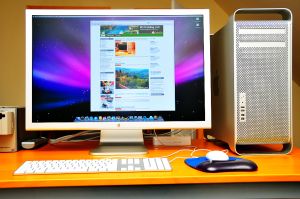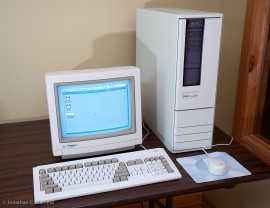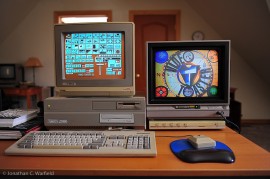
Mac Pro Meltdown

Here in the Northeastern U.S. (and other places, I’m sure) it’s been pretty darned hot and pretty darned humid. Today we had a thunderstorm roll through in the early afternoon and our power went out for a couple of minutes. When the power came back on, it killed my Mac.
Power outages are a fairly common occurrence where I live. The nearby county park has plenty of trees that seem to enjoy falling over onto power lines whenever there’s a stiff breeze. This time I’m guessing lightning knocked out the power. I was downstairs at the time when it happened, away from my computer. I heard my monster APC battery backup/surge protector beep loudly, protesting the lack of power, but in a few short minutes, power was back on and all seemed normal.
About an hour ago, I fired up my Mac Pro to do some surfing and…oops…blinking power light, no Mac desktop, cooling fans blowing loudly (which happens for a few seconds during a normal power on/boot-up, but then they rev down to a low whisper – not this time though). What could it be? Motherboard (please god no)? Video card? Hard drive? Memory? I didn’t know, so I did the only thing I could think of. Unseat or disconnect everything that could be unseated or disconnected, and reconnect one-by-one. I learned this from my recent experience with a collection of vintage Commodore Amiga computers.
If you’re not familiar with the Amiga, it’s an old computer that has a habit of suddenly not working for no apparent reason. Opening it up and reseating chips and processor boards (the not-so-distant cousin of simply banging on the thing until it works) usually does the trick. To be fair, these really are old (~20 years) computers and electrical connectors can get a bit “grotty” over time and lose conductivity.
Now my Mac is only about 2-1/2 years old, so it shouldn’t be suffering from grotty anything. So this was really a search for something that just plain broke.
First, I unseated all of the hard drives and reseated only the boot up drive. Unseated the memory boards and reseated only one, unseated and reseated the video card. Hold my breath and power on…
Woo-hoo! Booted up normally! Now, I reseated the other hard drives and powered on. Booted normally. Now the other memory board…Oops! Blinking powerlight and no worky. Got a bad memory chip or the memory board is bad. So, I started swapping memory chips and boards around and by process of elimination, I found one of my 2GB memory DIMM’s was bad.
Back in 2008 when I bought my Mac Pro, I upgraded the memory with four 2GB DIMMs from Other World Computing and now it looks like one of those went bad. Fortunately, OWC’s memory modules come with a lifetime warranty AND they have 24×7 Live Chat support. I chatted with Ray from OWC a short while ago while rifling through old receipts, and miraculously, I still had the original invoice from OWC for the purchase I had made over two years ago. Ray and I were able to quickly verify my order and submit a request for a replacement memory module.
This story has a happy ending, but it wasn’t without some reflection and some consideration on how this could have been a LOT worse. Here are some thoughts to consider:
- Don’t panic. Tell yourself not to over-react so you can start to think clearly. Your computer can contain digital versions of major chunks of your life, like all your financial records or works of digital art. All the more reason to stay calm in a crisis and solve the problem.
- Make backups! Really? You still need to be told to do this? With cheap, huge external hard drives and/or online backup solutions, there is NO REASON for you to not have backups. Even if my computer did suffer a major catastrophe, I have backups running at regular intervals on my machine. Once my computer was fixed, life would quickly return to normal. Backups should probably be listed as number 1., but not panicking is more universal for EVERY crisis.
- Use the process of elimination to get to the root of the problem. In this case, removing anything not essential to booting up the computer quickly let me know that my computer was basically OK and that something not critical was amiss. This saved me a lot of time over simply boxing up my machine and sending it back to Apple for who knows how long. Now, maybe you’re not technically inclined and would rather have an expert look at your machine instead of poking around and making matters worse. In that case…
- Know when to call in an expert. Don’t make matters worse by taking on things of a critical nature with which you have no experience. This can happen when you panic and aren’t thinking clearly. In this case, refer to item 1 above.
You might want to also add using a GOOD surge protector with battery backup which, at minimum, should allow you to quickly save your work and shut down your computer during a power outage. I do use one, but I still had a blow-out. I can’t be sure, but maybe it could have been a LOT worse if I didn’t have one. In either case, using one is probably better than not using one.

Anyway, it’s 11:15 pm here and I’m happily pecking away on my Mac that seemed dead just about an hour ago. I’m operating with 4GB less RAM (I had only one 2GB chip go bad, but Macs require chips to be installed in pairs. If one chip goes bad, you have to pull two out), but I am operational and able to breath a sigh of relief.
Is that smoke I smell? Time to NOT panic again!
Archives
- January 2026
- December 2025
- November 2025
- October 2025
- September 2025
- August 2025
- July 2025
- June 2025
- May 2025
- April 2025
- March 2025
- February 2025
- January 2025
- December 2024
- November 2024
- October 2024
- September 2024
- August 2024
- June 2024
- May 2024
- March 2024
- January 2024
- November 2023
- October 2023
- September 2023
- August 2023
- September 2013
- August 2013
- March 2013
- September 2012
- June 2012
- December 2011
- August 2011
- July 2011
- May 2011
- March 2011
- January 2011
- December 2010
- November 2010
- September 2010
- August 2010
- July 2010
- June 2010
- April 2010
- March 2010
- February 2010
- January 2010
- December 2009
- November 2009
- October 2009
- September 2009
- August 2009
- July 2009
- June 2009
- May 2009
- April 2009
- March 2009
- February 2009
- January 2009
- December 2008
- November 2008
- October 2008
- September 2008
- August 2008
- July 2008
- June 2008
- May 2008
- April 2008
- March 2008
- February 2008
- January 2008
- December 2007
- November 2007
- October 2007
- September 2007


Leave a Reply